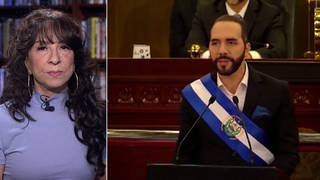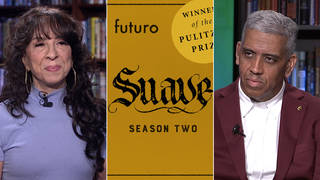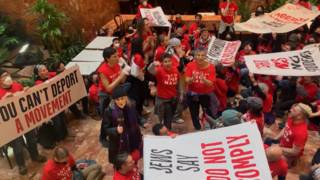
Guests
- Aixa RodriguezBronx-based high school ESL teacher in the New York City school system since 2005 and member of the United Federation of Teachers’ MORE Caucus, the Movement of Rank and File Educators.
- Eric Blancreporter for Jacobin and The Nation.
New York unions representing teachers and principals have reached a deal with the city over how to reopen the largest public school system in the United States, averting a planned strike by educators. “We feel betrayed, and we feel as if it’s an inadequate plan,” says Aixa Rodriguez, a Bronx-based high school teacher. We also speak with education writer Eric Blanc, who says New York has failed to learn the lessons of other school districts that reopened too quickly without adequate safety measures in place against COVID-19. “When educators in New York are saying it’s not safe to go back, that’s not just born out of paranoia; that’s born out of looking at what happens when you open schools,” says Blanc.
Transcript
AMY GOODMAN: This is Democracy Now! The Quarantine Report. I’m Amy Goodman, as we turn back here to New York City, where unions representing teachers and principals have reached a deal with the city to avert a strike by delaying the reopening of the largest public school system in the United States by two weeks.
New York is the only major urban school district in the country planning to reopen classrooms in the fall, though many students have opted for remote learning. The powerful United Federation of Teachers union had expressed concern over the lack of testing for teachers, the lack of protective gear, the condition of school buildings that lack good ventilation. The union’s executive committee was considering a strike as late as Monday. But after negotiations, New York City Mayor Bill de Blasio announced yesterday that New York’s 1.1 million schoolchildren will now start in-person instruction 10 days later than originally scheduled, on September 21st.
MAYOR BILL DE BLASIO: And what we’ve agreed to is to make sure that the health measures are in place, to make sure there is time for the appropriate preparation for our educators, to make sure that we can have the smoothest beginning of the school year, even under extraordinarily challenging conditions, and to move forward in a spirit of unity.
AMY GOODMAN: Agreeing to a major union demand, Mayor de Blasio said New York City would require monthly random testing of between 10 and 20% of students and staff at all city school buildings starting in October, with results ready within 48 hours.
For more on what this means here in New York and how it compares to school districts around the country, we’re joined by two guests. Aixa Rodriguez is a Bronx-based high school English as a second language teacher — ESL — member of United Federation of Teachers’ MORE Caucus. That’s the Movement of Rank and File Educators. Eric Blanc is a reporter for Jacobin and author of the book Red State Revolt: The Teachers’ Strike Wave and Working-Class Politics.
We welcome you both to Democracy Now! Aixa Rodriguez, let’s begin with you. How do you feel about the fact that your union did not go out on strike yesterday and has agreed to this two-week delay?
AIXA RODRIGUEZ: All of us jumped on a — can you hear me? All of us jumped on a conversation right afterwards. We feel betrayed, and we feel as if it is an inadequate plan. And we’re not happy.
AMY GOODMAN: What do you want to see? Explain what’s happening in New York City.
AIXA RODRIGUEZ: This was rushed. We want the receipts. They broke faith and broke trust. We have no faith in them since March, since the sickout that we were forced to have to close schools. We understand that the same problems still exist. We’re just being told with hyperbolic language how everything is going to be taken care of. We haven’t seen the receipts of all the repairs that are supposed to happen, and we do not believe it will happen in like 10 days. There’s no way.
AMY GOODMAN: Talk about who your students are, Aixa.
AIXA RODRIGUEZ: Well, my students — as an ESL teacher, my students are immigrants from all over the world. In my classroom, I have at least five continents and a whole bunch of languages represented. And for me, it’s a reality check that any infection that would happen between me and them, or them and me, could have serious consequences. I lost my grandmother to COVID. My mother was hospitalized. We were quarantined in here and Puerto Rico. Had I been in the classroom, I could have passed it to my African students, Dominican students, Mexican students, Bengali students, in five different boroughs. And I could have been the new Typhoid Mary, a superspreader event in all the different boroughs and multiple different communities that are vulnerable. So, this is a real situation for me because of the nature of who my students are.
AMY GOODMAN: So, can you talk about what you’ve said, that this makes you question whether Black lives matter? I mean, many parents of color are also deeply concerned and feel the other way, that they want their kids to be reconnected and to be in school. Your thoughts?
AIXA RODRIGUEZ: I don’t like remote learning, either. I want to be in school. But I know very well that the schools that many of these students are attending have been neglected for years, for decades. They do not have the HVAC systems with the filters that are necessary. The windows do not open. They’re claiming to have fixed it all, but the reality is, the teachers who have been in these buildings for a long time remember the times they were trying to fix PCBs in the windows and the asbestos, and we still know that mold and all those things have been happening for years.
So, these things are not going to be remedied immediately, and the kids are going to be put in these environments where there’s no soap, there’s no hot water, the kids can’t wash their hands, you know, the kids are going to be sitting in rows. It’s not going to be the same. It’s going to be two days out of the week. And —
AMY GOODMAN: How are they testing the air circulation, Aixa?
AIXA RODRIGUEZ: Testing the air circulation with toilet paper just to see that it’s coming out doesn’t mean that it’s actually good air. I worked in the Martin Luther King building, the same building where that video of the toilet paper test was happening. In fact, that room was on the fourth floor around the corner from my room. And I know that we can’t even handle basic issues in that room when it comes to smells after gym or after lunch, and having to have the door open, having to have a fan in that room, under regular circumstances, let alone understanding that we’re talking about the spread of COVID.
AMY GOODMAN: So, let me ask you about —
AIXA RODRIGUEZ: So, very oppressed as we’re feeling.
AMY GOODMAN: — a major union demand that the mayor did agree to, which is the city would require monthly random testing of between 10 and 20% of students and staff in all city school buildings starting in October, with results back in 48 hours. So, when you go back in, you are not being tested?
AIXA RODRIGUEZ: Not automatically. We got emails suggesting that we do.
AMY GOODMAN: And kids?
AIXA RODRIGUEZ: Highly suggesting — yeah, it’s a suggestion. It’s a hint. There’s no actual plan to make it happen before we set foot in there. It’s a highly suggestive thing, until they get this whole system running, which is why we felt as if this is not — this is not a deal. Like, what is this? It’s, you know, a very hyperbolic, “Oh, we’re the greatest school. We’re going to do the greatest plan, and we did the greatest this.” And then we find that nothing is in place.
AMY GOODMAN: I wanted to —
AIXA RODRIGUEZ: The nurses are not in place. Nothing.
AMY GOODMAN: And that’s important to talk about. We’re not just talking about teachers; you’re talking about the janitor staff, talking about the nurses — all of the staff that keep these schools going. And just explain: How does it work? Are kids going back every day or a portion of every week? And can kids opt total remote?
AIXA RODRIGUEZ: So, kids can opt total remote. Definitely, they can. The kids who have opted for blended, because parents want to go back to work. We want a little bit of normalcy. They will come two days out of the week and switch the other two days — the other group of kids will come the other two days. So, it’s not like a five-day week. And a lot of parents brought up, “Hold up. Wait a minute. I can’t work like this. My job doesn’t function two days a week. I still have to find child care or some type of supervision for the other three days.” So, it’s a false normal. It’s still remote, regardless of them saying that it’s going to be in person. Three days out of the week will still be remote.
AMY GOODMAN: So, you’re with MORE. MORE is the caucus of UFT. UFT has now agreed with and applauded the mayor for delaying the reopening of the schools, but, moving forward with that, threatening a strike. Are you talking about a wildcat strike?
AIXA RODRIGUEZ: The feeling of betrayal is very, very big. And the fear of life and death is still there. So, I mean, the reality is, the Unity Caucus has been in charge for 60 years, and this is the — we expected to be betrayed, and here we are again, you know, getting our hopes up to actually see some changes and some fixes, and then not even a vote, and a very undemocratic process to even like vote for a vote. To even say that we’re going to have a vote was undemocratic. Overnight, with less than 24 hours, no chances for delegates to talk to their chapters and discuss it with the rank and file. So, there’s many rank and file who really feel as if they have no choice, because their son has chemo and is sick, and they are not allowed to get a medical accommodation because it’s not their condition that’s the problem, their child’s condition.
AMY GOODMAN: Aixa, very quickly, at the beginning of the pandemic, how did the city deal with the pandemic? Do you know how many staff and how many students died here in New York City?
AIXA RODRIGUEZ: So, here’s the question. We got something from 79 to 100 teachers. And the way teachers were labeled or educators were labeled didn’t give a full picture, because they started to chop up the groups. School safety agents were listed under NYPD. Anybody who was under DC 37, the cafeteria workers, custodial, all of those, listed under there, 150, that number. So, if you add up all the different pieces — CSA, which is the administration; the educators that are teachers, also paraprofessionals — it was a significant number, like just like 300, 400 people.
And I have no clue about the students; just anecdotally, from here and there, because a lot of the kids survived, people are still around, but now have health conditions that are lingering from COVID.
So, yeah, the numbers being like talked about is not a full number, because we’re not including everybody who works in a school. If we were to talk about everybody who works in a school, including every single one of those small populations, that’s a bigger number than the 79 to 100 that we’re told were a UFT member.
AMY GOODMAN: Which is still horrifying. Eric Blanc, I wanted to turn to you to put New York in a national context. You wrote the book Red State Revolt: The Teachers’ Strike Wave and Working-Class Politics. Talk about New York being the only school district opting to stay open, the power of the teachers around the country, and what’s happening — the only major school district in the country.
ERIC BLANC: Right. This is the first thing that needs to be highlighted, is that all other big cities in the United States right now have begun with remote learning. And there’s a reason for that: It’s not safe to open schools in the middle of a raging pandemic. Look at Florida. Florida is a really good example. This is one of the exceptions. Florida opened their schools. You’ve seen in the last two-and-a-half weeks a 23% rise in transmission rates amongst children. Just recently, a 6-year-old girl died from the virus. And so, when educators in New York are saying it’s not safe to go back, that’s not just born out of paranoia; that’s born out of looking at what happens when you open the schools.
Other major cities have closed, thankfully, and that’s because of this movement we’ve seen all across the country, a really unprecedented upsurge. It’s even higher than the strikes we saw in 2018 and 2019 in West Virginia, Chicago, Los Angeles. We’ve seen really an unprecedented upsurge all across the country of educators fighting, because they understand this is life or death, not just for themselves, but for their students, for the parents, for the community.
So, I just see, every day, new districts, in red states, blue states, in which teachers are organizing actions. They’re getting on Zoom calls. They’re speaking with parents. And they’re saying, “We want to go back to our classrooms, but only when it’s safe.” That means fully funding our schools. It means taxing the rich, so that we can have safe and equitable schools.
AMY GOODMAN: How responsive have the union leadership been to the rank and file around the country?
ERIC BLANC: Yeah, it’s very uneven. Thankfully, you see really progressive unions, like in Chicago, in Los Angeles, taking the lead of organizing with the rank and file, meeting with parents, and building really the kind of social justice unionism, together with the ranks and parents, to make it so that they were able to keep the schools remote learning in the fall and raise demands on behalf of parents so that the schools are not just opened safely, but fully funded. So, when you see progressive union leadership in alliance with the rank and file, the changes have been really major.
Unfortunately, there are examples — and New York is one of them — in which you see union leaders oftentimes leaning more towards an alliance with Democratic politicians rather than their own memberships. And that’s pitted the leadership against the ranks, because the ranks understand, probably better than anybody else, the conditions in the schools, the fears of the parents, and the understanding that the way you win against billionaires and the politicians that are bought off is not by backroom deals, but through organizing. And it’s through, if necessary, taking disruptive action to force the politicians to do the right thing. Where union leaders have had that stance, they’ve had tremendous support with the ranks. But where they haven’t, you’ve seen real conflicts. And that’s what I think you’re seeing in New York right now.
AMY GOODMAN: What is the push to open the schools? And what about the disparity in learning of wealthier kids who can do it online, have good internet, have computers, have space, and poorer kids? And how do you deal with this?
ERIC BLANC: Yeah, there’s a tremendous amount of hypocrisy being put out there right now, because, nominally, the reason that the schools are being reopened is politicians are saying it’s placing an inordinate burden on working-class parents. There’s some truth to this. Remote learning hurts everybody. But the reality is: Who are the parents who in New York City are going to have the opportunity right now to keep their kids at home? It’s parents who are richer, who are whiter, who have the money to hire child care or to stay at home themselves. So, who’s going to suffer from a premature opening are working-class communities of color, who are forced, by necessity, to send their kids into the schools.
And the reality is, this crisis is a racial justice crisis, and it’s an equity crisis, because you have 118 billionaires in New York alone — right? — who have seen their wealth increase by $45 billion just since the beginning of the pandemic. Why aren’t they paying their fair share? If we tax them sufficiently, you would have more than enough money so that working-class parents, so that communities of color could have a safe reopening, and so parents and educators and students could feel safe. But the fact that we are not taxing the rich like they should means that it’s a lose-lose situation. Remote learning is not a good situation, but it’s even more catastrophic to have a premature school reopening.
AMY GOODMAN: Eric Blanc, I want to thank you for being with us, reporter with Jacobin and The Nation, and Aixa Rodriguez, a New York City ESL teacher, UFT MORE Caucus. That’s the Movement of Rank and File Educators.
Next up, as President Trump visits Kenosha without saying Jacob Blake’s name once, we’ll speak to, well, the former digital editor of the Kenosha News. He just resigned his position in protest of a headline he says mischaracterized an early rally for Jacob Blake. Stay with us.











Media Options